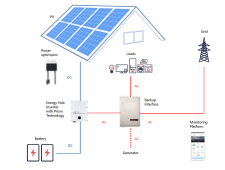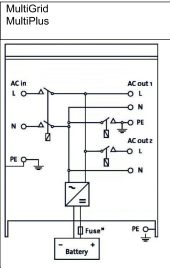DelcoMade
New Member
Good Morning Everyone,
I recently had a system installed that provides 81% offset. We have 20 - 400W URECO FBM400MFG-BB Panels, with a SolarEdge HD wave inverter SE7600H. We were originally at 102% offset but the utility company would have had to do upgrades at my cost to allow the system. We were back and fourth with adding two batteries to back up the system in the event of a power outage but because of the cost and only 10 year warrantied batteries, we opted to not install a battery bank but were told they would be easily added (plug and play) at a later date.
Before agreeing on the system, I asked multiple times if there was an option for Daytime Solar in the event of a power outage, knowing the panels get switched off the grid to not back feed. I was told multiple times that the technology isn't there yet and that there are micro-inverters that store very little power and wouldn't be enough for anything. During the final installation, I spoke with the electrician (subcontracted) about future options. He explained that daytime solar is easily obtainable with the addition of a transfer switch and a control panel/box and explained how it would work. He also said that yes, batteries banks can easily added if the correct inverter is in place. He took the cover off the inverter to find that its just a basic inverter not equipped for a (plug and play) battery and or generator.
I asked my sales guy, why after all of our discussion about adding batteries in the future or possibly a generator, and being told that they could easily be added in the future (plug and play) that a basic inverter was added?
So finally my question, sorry for the long background lead up.
What would be needed to allow for daytime solar during a grid power outage and what else is needed to add a battery bank and or generator? Inside my invertor there appears to be a space that could accommodate some of the components included in better battery ready invertors.
Thank you in advance, I look forward to everyones input.
I recently had a system installed that provides 81% offset. We have 20 - 400W URECO FBM400MFG-BB Panels, with a SolarEdge HD wave inverter SE7600H. We were originally at 102% offset but the utility company would have had to do upgrades at my cost to allow the system. We were back and fourth with adding two batteries to back up the system in the event of a power outage but because of the cost and only 10 year warrantied batteries, we opted to not install a battery bank but were told they would be easily added (plug and play) at a later date.
Before agreeing on the system, I asked multiple times if there was an option for Daytime Solar in the event of a power outage, knowing the panels get switched off the grid to not back feed. I was told multiple times that the technology isn't there yet and that there are micro-inverters that store very little power and wouldn't be enough for anything. During the final installation, I spoke with the electrician (subcontracted) about future options. He explained that daytime solar is easily obtainable with the addition of a transfer switch and a control panel/box and explained how it would work. He also said that yes, batteries banks can easily added if the correct inverter is in place. He took the cover off the inverter to find that its just a basic inverter not equipped for a (plug and play) battery and or generator.
I asked my sales guy, why after all of our discussion about adding batteries in the future or possibly a generator, and being told that they could easily be added in the future (plug and play) that a basic inverter was added?
So finally my question, sorry for the long background lead up.
What would be needed to allow for daytime solar during a grid power outage and what else is needed to add a battery bank and or generator? Inside my invertor there appears to be a space that could accommodate some of the components included in better battery ready invertors.
Thank you in advance, I look forward to everyones input.





